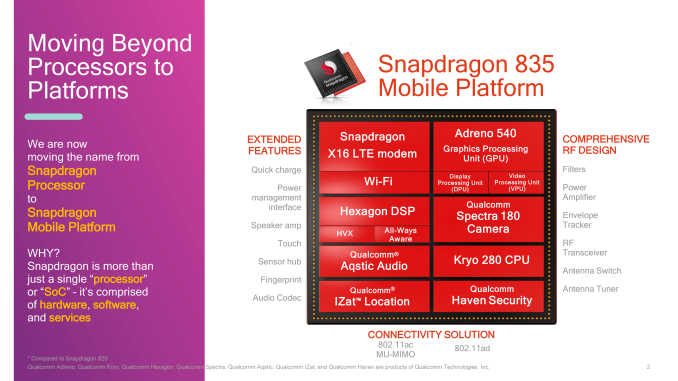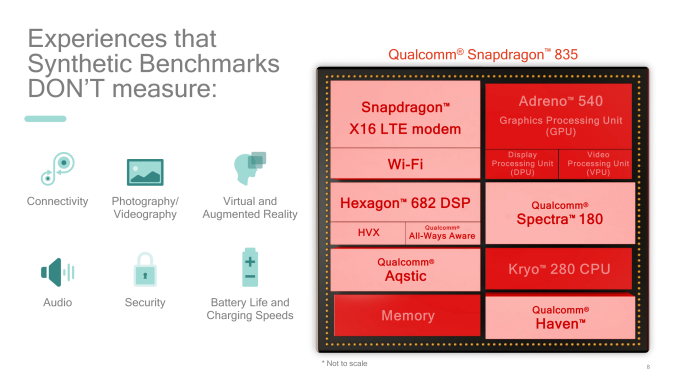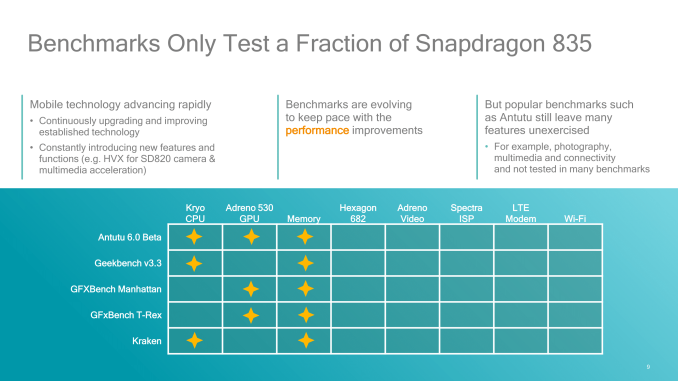The Qualcomm Snapdragon 835 Performance Preview
by Matt Humrick & Ryan Smith on March 22, 2017 4:30 AM EST- Posted in
- Smartphones
- Snapdragon
- Qualcomm
- Mobile
- SoCs
- Snapdragon 835
- Kryo
Qualcomm's Thoughts on Benchmarks versus End-User Experiences
While the primary purpose of our visit out to Qualcomm’s offices was for benchmarking, for this year’s event Qualcomm went one step further and invited us to take a tour of some of their labs. The tour itself was plenty interesting (more on this in a bit), however arguably the more important aspect of the tour isn’t what we saw, but why Qualcomm is giving the press lab tours after so long. A tour may sound trite, but for Qualcomm it’s a sign of bigger things.
Perhaps the most important thing to understand about Qualcomm is that while the bulk of the company’s revenue comes from chips, the majority of their actual profits come from various technology and patent licensing programs. The actual breakdown between the two halves of Qualcomm gets a bit weird when trying to best account for which half foots the bill for R&D, but at the end of the day it’s Qualcomm’s licensing business that is making them the most money.
| Qualcomm Financials (FY'2016) | ||||
| Chip-Making | Licensing | |||
| Revenue | $15.4B | $7.6B | ||
| Profit (Pretax) | $1.8B | $6.5B | ||
As a result, if boardroom-level rumors are to be believed, the company is never quite sure how to balance the two businesses. Some groups want licensing and chip design separated, and others want them to stay combined. Qualcomm seems content to stick with the status quo and their $5.7B in profits for 2016, but as a consequence of this unusual split it means that the chip side of Qualcomm is always under a bit of pressure to prove itself.
The good news for the chip business is that it’s doing fairly well, especially in North America. Most high-end Android smartphones sold in the US are based on Qualcomm’s chips, Qualcomm’s modems are in some (but no longer all) of Apple’s iPhone SKUs, and even in the midrange market Qualcomm’s Snapdragon 600 series chips are in a number of popular phones. The flip side of this is that outside of the US and especially outside of the high-end, Qualcomm’s chip business is under constant pressure from both their partners and their competitors. Samsung is happy to stick with their own home-grown Exynos chips outside of North America, and other chip vendors like MediaTek nip at Qualcomm’s heels with competent midrange SoCs that are priced very aggressively. So while Qualcomm’s chip business is doing well right now, that could very well change in the future.
But what does this have to do with a press tour of their labs? One of the big initiatives for Qualcomm, as exemplified in last week’s Snapdragon branding tweak, is that the chip arm of the company wants to get away from being so frequently judged on the basis of their CPU and only their CPU. This is why Snapdragon is now a platform versus a processor, and similarly, it’s why we’re going to see Qualcomm increasingly talking up the other aspects of their SoCs in the future. Their SoCs and associated front-end hardware are more than just the Kryo CPU, and they want the world to know that.
For Qualcomm this move makes a lot of sense. CPU performance is still growing year-after-year, but as we’ve seen, those gains are plateauing some as a consequence of diminishing IPC gains and diminishing clockspeed gains. Meanwhile, although the Kryo is a customized CPU design, as we’ve seen in our benchmark data it doesn’t behave radically different from ARM’s Cortex-A72 and Cortex-A73 designs that other vendors can license. Short of a “Cyclone” moment for Qualcomm, their CPU performance is close enough to the rest of the Android pack that they can’t clearly stand out from other vendors in the way Apple can. And that means they need to promote and sell their SoCs as the sum of their parts, and not just a CPU with a bunch of extra stuff bolted on.
This also means that even though Qualcomm is one of the first vendors to ship a 10nm high-end SoC – and enjoying the performance benefits thereof – we’re also going to see the company downplay benchmarks a bit for not capturing the complete “end-user experience.”
And to the company’s credit, they aren’t wrong. CPU, GPU, and memory performance are all easy enough to test, vary a great deal among SoC designs, and are similarly easy to communicate. DSPs, ISPs, and other aspects are not nearly as easy to test, never mind communicating those advantages to a wider audience.
Still, once we get outside of CPU/GPU/memory and into other functional blocks of a SoC, things get murkier for everyone. A video decode block may as well be a static piece of hardware – as long as it does its job well, no one will notice – and a great Wi-Fi radio can be kneecapped by a bad device design. So as much as Qualcomm wants to push the broader end-user experience, they will never completely escape the fact that the core features of their SoCs will be the first to be put to the test, and that wider testing is going to be less meaningful to customers, or more practically speaking outside the budgets of technology journalists.













128 Comments
View All Comments
lefty2 - Wednesday, March 22, 2017 - link
The iPhone 7 also scores a lot better in BaseMark OS II as well. At that stage we are looking at 3 benchmarks where iPhone trounces the best Android - although you can pick minor problems with each benchmark if you want - the overall picture is that the A10 performs better.joms_us - Wednesday, March 22, 2017 - link
A10 is better than SD821 by small margin in Basemark, SD835 will demolish it.lefty2 - Wednesday, March 22, 2017 - link
I didn't see SD821, but the A10 beats SD820 by a huge margin (almost double):http://www.anandtech.com/show/10685/the-iphone-7-a...
joms_us - Wednesday, March 22, 2017 - link
Check this one...http://www.gsmarena.com/oneplus_3t-review-1531p5.p...
Meteor2 - Wednesday, March 22, 2017 - link
I thought the whole point of Geekbench was that it used specific compilers for each ISA specifically so it *is* comparable.melgross - Wednesday, March 22, 2017 - link
Yes, and that's important. Too many benchmarks, in order to have some kind of equivelance, don't compile specifically to a particular chip. They don't support specific functions, so it may not be a comparable test. They must support, and properly, all of the features of a chip family.BurntMyBacon - Wednesday, March 22, 2017 - link
@lefty2: "So, yankeeDDL is correct, Apple's A10 trounces everything else (in single thread, which is the most important in a smartphone)."1) yankeeDDL did not make the single thread qualification that you made. Nor was any benchmark outside of this review mentioned. Therefore, yankeeDDL was not correct, regardless of the accuracy of your take on the situation.
2) You are using a single data point to disregard the entire benchmark suite here. Disregarding the perfectly legitimate reasons why the reviewers have chosen to leave geekbench out of the review suite, this still only gives the A10 one more win. Even then, you are purposefully leaving out the multi core data point, which puts the A10 only slightly ahead of Exynos 8890 in the Galaxy S7. I suspect, but can't confirm, that the A10 would lose to both the Kirin 960 and the Kryo 280. Yes, single threaded performance is important, but the Geekbench workload clearly isn't representative of all workloads.
Don't worry, the A10 isn't suddenly slow. It still ranks among the fastest SoCs on the market and is even still the top dog for certain senarios. Furthermore, platform optimizations and better use of APIs (see the javascript and basemark benchmarks) will likely hide any minor deficiencies until the A11(?) is released.
lefty2 - Wednesday, March 22, 2017 - link
I disregard multi threaded because most smartphone apps don't use multiple threads. Even for desktop PCs, single threaded performance is more important that multi threadedDrumsticks - Wednesday, March 22, 2017 - link
Didn't anandtech do an analysis of Android a while ago and find pretty much the exact opposite? And that was like a year ago so it can only have gotten better since then.lefty2 - Wednesday, March 22, 2017 - link
If they did, it must have been a very flawed analysis. Most people agree that single threaded performance is always the most important.